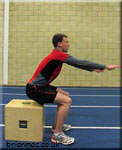

Squats Test
Testing and measurement are the means of collecting information upon which subsequent performance evaluations and decisions are made. In the analysis, we need to consider factors influencing the results.
Objective
This test aims to monitor the development of the athlete's leg strength.
Required Resources
To conduct this test, you will require:
- A chair or box that makes the athlete's knees bend at right angles when they are sitting.
- Assistant.
How to conduct the test
This test requires the athlete to complete as many squats as possible with no rest.
|
 |
Assessment
The following normative data is available for this test.
The following tables provide normative data for adults - source unknown.
Male
| Age | 18-25 | 26-35 | 36-45 | 46-55 | 56-65 | 65+ |
| Excellent | >49 | >45 | >41 | >35 | >31 | >28 |
| Good | 44-49 | 40-45 | 35-41 | 29-35 | 25-31 | 22-28 |
| Above average | 39-43 | 35-39 | 30-34 | 25-38 | 21-24 | 19-21 |
| Average | 35-38 | 31-34 | 27-29 | 22-24 | 17-20 | 15-18 |
| Below Average | 31-34 | 29-30 | 23-26 | 18-21 | 13-16 | 11-14 |
| Poor | 25-30 | 22-28 | 17-22 | 13-17 | 9-12 | 7-10 |
| Very Poor | <25 | <22 | <17 | <9 | <9 | <7 |
Female
| Age | 18-25 | 26-35 | 36-45 | 46-55 | 56-65 | 65+ |
| Excellent | >43 | >39 | >33 | >27 | >24 | >23 |
| Good | 37-43 | 33-39 | 27-33 | 22-27 | 18-24 | 17-23 |
| Above average | 33-36 | 29-32 | 23-26 | 18-21 | 13-17 | 14-16 |
| Average | 29-32 | 25-28 | 19-22 | 14-17 | 10-12 | 11-13 |
| Below Average | 25-28 | 21-24 | 15-18 | 10-13 | 7-9 | 5-10 |
| Poor | 18-24 | 13-20 | 7-14 | 5-9 | 3-6 | 2-4 |
| Very Poor | <18 | <20 | <7 | <5 | <3 | <2 |
Analysis
Analysis of the test result compares it with the athlete's previous results for this test. It is expected that the analysis would indicate an improvement in the athlete's leg strength with appropriate training between each test.
Target Group
This test is suitable for active athletes but not for individuals where the test would be contraindicated.
Reliability
Test reliability refers to how a test is consistent and stable in measuring its intended measure. Reliability will depend upon how strictly the test is conducted and the individual's level of motivation to perform the test. The following link provides various factors influencing the results and test reliability.
Validity
Test validity refers to the degree to which the test measures what it claims to measure and the extent to which inferences, conclusions, and decisions based on test scores are appropriate and meaningful. This test provides a means to monitor training on the athlete's physical development.
Advantages
- Minimal equipment is required.
- Simple to set up and conduct.
- It can be conducted almost anywhere.
Disadvantages
- Specific facilities are required.
- An assistant is required to administer the test.
Page Reference
If you quote information from this page in your work, then the reference for this page is:
- MACKENZIE, B. (2005) Squats Test [WWW] Available from: https://www.brianmac.co.uk/squatest.htm [Accessed